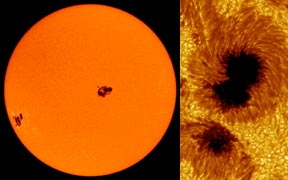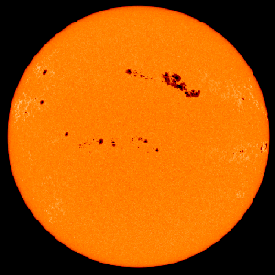The Sun on March 30, 2001. You can see the huge sunspot in the upper, right hand part of the Sun. Though it doesn't look like much, this area is equivalent to the surface area of 14 Earths! The sunspot has since moved so that it is on the far side of the Sun from Earth.
Click on image for full size
Courtesy of Spaceweather.com
Massive Sunspot! (Updated!)
News story originally written on April 4, 2001
The largest sunspot of the decade has shown up on the Sun. It let off the largest solar flare and coronal mass ejection (CME) of the decade on Monday, April 2!
This flare and CME won't hit Earth directly. But, there still may be increased auroral activity the nights of April 4th-5th.
If this solar event had struck Earth directly, there might have been serious radio disruptions or power blackouts!
Stay tuned to Spaceweather.com for updates!
You might also be interested in:

Sunspots are dark, planet-sized regions that appear on the "surface" of the Sun. Sunspots are "dark" because they are colder than the areas around them. A large sunspot might have a temperature of about
...more
It was another exciting and frustrating year for the space science program. It seemed that every step forward led to one backwards. Either way, NASA led the way to a great century of discovery. Unfortunately,
...more
The Space Shuttle Discovery lifted off from Kennedy Space Center on October 29th at 2:19 p.m. EST. The weather was great as Discovery took 8 1/2 minutes to reach orbit. This was the United States' 123rd
...more
A moon was discovered orbiting the asteroid, Eugenia. This is only the second time in history that a satellite has been seen circling an asteroid. A special mirror allowed scientists to find the moon
...more
Will Russia ever put the service module for the International Space Station in space? NASA officials want an answer from the Russian government. The necessary service module is currently waiting to be
...more
A coronal mass ejection (CME) happened on the Sun early last month. The material that was thrown out from this explosion passed the ACE spacecraft. The SWICS instrument on ACE has produced a new and very
...more
J.S. Maini of the Canadian Forest Service called forests the "heart and lungs of the world." This is because forests filter air and water pollution, absorb carbon dioxide, release oxygen, and maintain
...more















